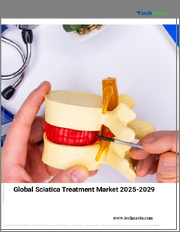
|
시장보고서
상품코드
1647511
세계의 좌골 신경통 치료 시장 규모, 점유율, 성장 분석 : 유형별, 약제 클래스별, 유통 채널별, 지역별 - 산업 예측(2025-2032년)Sciatica Treatment Market Size, Share, and Growth Analysis, By Type (Acute, Chronic), By Drug Class (Nonsteroidal Anti-Inflammatory Drugs (NSAIDs), Corticosteroids), By Distribution Channel, By Region - Industry Forecast 2025-2032 |
||||||
좌골 신경통 치료 세계 시장 규모는 2023년에 7억 3,474만 달러로 평가되었습니다. 또한, 2024년 7억 6,486만 달러에서 2032년에는 10억 5,485만 달러로 성장할 것으로 예상되며, 예측 기간(2025-2032년) 동안 4.1%의 연평균 복합 성장률(CAGR)을 나타낼 전망입니다.
시장 인사이트에 따르면 좌골신경통은 좌식 생활습관, 비만율 증가, 노령화 등이 큰 영향을 미치며, 좌골신경통 환자가 증가하는 추세에 있습니다. 이 질환은 좌골 신경을 따라 방사통으로 나타나며, 추간판탈출증, 골극, 척추관 협착증과 관련이 있는 경우가 많습니다. 진단 기술의 발전으로 좌골신경통의 식별은 더욱 향상되었고, 그 결과 보고되는 사례는 급증하고 있습니다. 조사에 따르면, 약 40%의 사람들이 좌골신경통을 경험하며, 그 빈도는 40-50세에서 가장 높으며, 여성보다 남성에게 더 많이 발생합니다. 좌골신경통에 대한 인식과 진단이 향상됨에 따라, 좌골신경통의 근본적인 원인을 해결하는 것이 증가하는 환자 집단에 미치는 영향을 관리하는 데 필수적일 것입니다.
목차
서론
- 조사 목적
- 조사 범위
- 정의
조사 방법
- 정보 조달
- 2차 데이터와 1차 데이터 방법
- 시장 규모 예측
- 시장 전제조건과 제한
주요 요약
- 세계 시장 전망
- 공급과 수요 동향 분석
- 부문별 기회 분석
시장 역학과 전망
- 시장 개요
- 시장 규모
- 시장 역학
- 성장 촉진요인과 기회
- 성장 억제요인과 과제
- Porter의 Five Forces 분석
주요 시장 인사이트
- 중요 성공 요인
- 경쟁 정도
- 주요 투자 기회
- 시장 생태계
- 시장의 매력 지수(2024년)
- PESTEL 분석
- 거시경제 지표
- 밸류체인 분석
- 가격 분석
좌골 신경통 치료 시장 규모 : 유형별
- 시장 개요
- 급성
- 만성
- 기타
좌골 신경통 치료 시장 규모 : 약제 클래스별
- 시장 개요
- 비스테로이드성 항염증제(NSAID)
- 코르티코스테로이드
- 항우울제
- 기타
좌골 신경통 치료 시장 규모 : 유통 채널별
- 시장 개요
- 병원 약국
- 소매 약국 및 온라인 약국
좌골 신경통 치료 시장 규모
- 북미
- 미국
- 캐나다
- 유럽
- 독일
- 스페인
- 프랑스
- 영국
- 이탈리아
- 기타 유럽
- 아시아태평양
- 중국
- 인도
- 일본
- 한국
- 기타 아시아태평양
- 라틴아메리카
- 브라질
- 기타 라틴아메리카
- 중동 및 아프리카
- GCC 국가
- 남아프리카공화국
- 기타 중동 및 아프리카
경쟁 정보
- 주요 5개사 비교
- 주요 기업의 시장 포지셔닝(2024년)
- 주요 시장 기업이 채택한 전략
- 시장 최근 동향
- 기업의 시장 점유율 분석(2024년)
- 주요 기업 개요
- 기업 개요
- 제품 포트폴리오 분석
- 부문별 점유율 분석
- 매출 전년대비 비교(2022-2024년)
주요 기업 개요
- Pfizer Inc.(United States)
- Novartis AG(Switzerland)
- Johnson & Johnson(United States)
- Teva Pharmaceutical Industries Ltd.(Israel)
- Endo Pharmaceuticals(United States)
- Stryker Corporation(United States)
- Medtronic PLC(Ireland)
- Abbott Laboratories(United States)
- Bayer AG(Germany)
- Sanofi S.A.(France)
- AstraZeneca PLC(United Kingdom)
- Amneal Pharmaceuticals, Inc.(United States)
- Aurobindo Pharma Limited(India)
- Sun Pharmaceutical Industries Ltd.(India)
- Sorrento Therapeutics, Inc.(United States)
- Alkem Laboratories Ltd.(India)
- Eliem Therapeutics, Inc.(United States)
- Sinfonia Biotherapeutics(United States)
- Omega Laser Systems Ltd.(United Kingdom)
결론과 추천 사항
LSH 25.03.04Global Sciatica Treatment Market size was valued at USD 734.74 million in 2023 and is poised to grow from USD 764.86 million in 2024 to USD 1054.85 million by 2032, growing at a CAGR of 4.1% during the forecast period (2025-2032).
Market insights indicate a rising trend in sciatica cases, largely influenced by sedentary lifestyles, increasing obesity rates, and an aging demographic. This condition manifests as pain radiating along the sciatic nerve, often related to herniated disks, bone spurs, or spinal stenosis. Advancements in diagnostic technologies have further improved the identification of sciatica, resulting in a surge of reported cases. Research shows that around 40% of individuals will experience sciatica at some point, with the highest frequency observed in those aged 40 to 50, and a greater prevalence in men compared to women. As awareness and diagnosis improve, addressing sciatica's underlying causes will be essential for managing its impact on the growing patient population.
Top-down and bottom-up approaches were used to estimate and validate the size of the Global Sciatica Treatment market and to estimate the size of various other dependent submarkets. The research methodology used to estimate the market size includes the following details: The key players in the market were identified through secondary research, and their market shares in the respective regions were determined through primary and secondary research. This entire procedure includes the study of the annual and financial reports of the top market players and extensive interviews for key insights from industry leaders such as CEOs, VPs, directors, and marketing executives. All percentage shares split, and breakdowns were determined using secondary sources and verified through Primary sources. All possible parameters that affect the markets covered in this research study have been accounted for, viewed in extensive detail, verified through primary research, and analyzed to get the final quantitative and qualitative data.
Global Sciatica Treatment Market Segments Analysis
Global Sciatica Treatment Market is segmented by Type, Drug Class, Distribution Channel and region. Based on Type, the market is segmented into Acute, Chronic and Others. Based on Drug Class, the market is segmented into Nonsteroidal Anti-Inflammatory Drugs (NSAIDs), Corticosteroids, Antidepressants and Others. Based on Distribution Channel, the market is segmented into Hospital Pharmacies and Retail & Online Pharmacies. Based on region, the market is segmented into North America, Europe, Asia Pacific, Latin America and Middle East & Africa.
Driver of the Global Sciatica Treatment Market
The global Sciatica Treatment market is significantly influenced by the high prevalence of sciatica, a condition affecting 10-40% of the population, particularly among older individuals, with a lifetime occurrence rate of up to 43%. This rising incidence of both chronic and acute cases, especially in adults aged 60 and above, where rates soar to 19.2%, drives the demand for effective treatments. While surgical options like microdiscectomy or spinal fusion are available, their high costs present accessibility challenges, particularly in low- and middle-income nations with limited healthcare resources. Emerging treatments, such as stem cell therapy, though promising, may also lack adequate insurance coverage, further complicating patient access to necessary care.
Restraints in the Global Sciatica Treatment Market
The Global Sciatica Treatment market faces significant restraints primarily due to the high costs associated with surgical interventions, such as microdiscectomy and spinal fusion, which are commonly recommended for sciatica relief. Furthermore, emerging therapies like stem cell treatment, despite their potential benefits, also come with increased expenses, and there is uncertainty regarding insurance coverage for these advanced procedures. These financial burdens create substantial barriers, restricting access to various treatment options, especially for patients in low- and middle-income nations where healthcare resources are limited. Ultimately, the economic constraints significantly hinder the ability to seek adequate sciatica care for many individuals.
Market Trends of the Global Sciatica Treatment Market
The Global Sciatica Treatment Market is experiencing significant growth, driven largely by advancements in diagnostic imaging technologies such as MRI and CT scans. These innovations have transformed the identification of sciatica's underlying causes, allowing for faster and more accurate diagnoses, which facilitate timely interventions. Early detection is essential in averting the progression from acute sciatica to chronic, debilitating conditions. Enhanced diagnostic precision empowers healthcare providers to deliver effective treatments promptly, improving patient outcomes and reducing the risk of disability. Additionally, the increasing prevalence of sciatica cases is further propelling market expansion, underscoring the importance of innovative solutions in managing this condition.
Table of Contents
Introduction
- Objectives of the Study
- Scope of the Report
- Definitions
Research Methodology
- Information Procurement
- Secondary & Primary Data Methods
- Market Size Estimation
- Market Assumptions & Limitations
Executive Summary
- Global Market Outlook
- Supply & Demand Trend Analysis
- Segmental Opportunity Analysis
Market Dynamics & Outlook
- Market Overview
- Market Size
- Market Dynamics
- Drivers & Opportunities
- Restraints & Challenges
- Porters Analysis
- Competitive rivalry
- Threat of substitute
- Bargaining power of buyers
- Threat of new entrants
- Bargaining power of suppliers
Key Market Insights
- Key Success Factors
- Degree of Competition
- Top Investment Pockets
- Market Ecosystem
- Market Attractiveness Index, 2024
- PESTEL Analysis
- Macro-Economic Indicators
- Value Chain Analysis
- Pricing Analysis
Global Sciatica Treatment Market Size by Type & CAGR (2025-2032)
- Market Overview
- Acute
- Chronic
- Others
Global Sciatica Treatment Market Size by Drug Class & CAGR (2025-2032)
- Market Overview
- Nonsteroidal Anti-Inflammatory Drugs (NSAIDs)
- Corticosteroids
- Antidepressants
- Others
Global Sciatica Treatment Market Size by Distribution Channel & CAGR (2025-2032)
- Market Overview
- Hospital Pharmacies
- Retail & Online Pharmacies
Global Sciatica Treatment Market Size & CAGR (2025-2032)
- North America (Type, Drug Class, Distribution Channel)
- US
- Canada
- Europe (Type, Drug Class, Distribution Channel)
- Germany
- Spain
- France
- UK
- Italy
- Rest of Europe
- Asia Pacific (Type, Drug Class, Distribution Channel)
- China
- India
- Japan
- South Korea
- Rest of Asia-Pacific
- Latin America (Type, Drug Class, Distribution Channel)
- Brazil
- Rest of Latin America
- Middle East & Africa (Type, Drug Class, Distribution Channel)
- GCC Countries
- South Africa
- Rest of Middle East & Africa
Competitive Intelligence
- Top 5 Player Comparison
- Market Positioning of Key Players, 2024
- Strategies Adopted by Key Market Players
- Recent Developments in the Market
- Company Market Share Analysis, 2024
- Company Profiles of All Key Players
- Company Details
- Product Portfolio Analysis
- Company's Segmental Share Analysis
- Revenue Y-O-Y Comparison (2022-2024)
Key Company Profiles
- Pfizer Inc. (United States)
- Company Overview
- Business Segment Overview
- Financial Updates
- Key Developments
- Novartis AG (Switzerland)
- Company Overview
- Business Segment Overview
- Financial Updates
- Key Developments
- Johnson & Johnson (United States)
- Company Overview
- Business Segment Overview
- Financial Updates
- Key Developments
- Teva Pharmaceutical Industries Ltd. (Israel)
- Company Overview
- Business Segment Overview
- Financial Updates
- Key Developments
- Endo Pharmaceuticals (United States)
- Company Overview
- Business Segment Overview
- Financial Updates
- Key Developments
- Stryker Corporation (United States)
- Company Overview
- Business Segment Overview
- Financial Updates
- Key Developments
- Medtronic PLC (Ireland)
- Company Overview
- Business Segment Overview
- Financial Updates
- Key Developments
- Abbott Laboratories (United States)
- Company Overview
- Business Segment Overview
- Financial Updates
- Key Developments
- Bayer AG (Germany)
- Company Overview
- Business Segment Overview
- Financial Updates
- Key Developments
- Sanofi S.A. (France)
- Company Overview
- Business Segment Overview
- Financial Updates
- Key Developments
- AstraZeneca PLC (United Kingdom)
- Company Overview
- Business Segment Overview
- Financial Updates
- Key Developments
- Amneal Pharmaceuticals, Inc. (United States)
- Company Overview
- Business Segment Overview
- Financial Updates
- Key Developments
- Aurobindo Pharma Limited (India)
- Company Overview
- Business Segment Overview
- Financial Updates
- Key Developments
- Sun Pharmaceutical Industries Ltd. (India)
- Company Overview
- Business Segment Overview
- Financial Updates
- Key Developments
- Sorrento Therapeutics, Inc. (United States)
- Company Overview
- Business Segment Overview
- Financial Updates
- Key Developments
- Alkem Laboratories Ltd. (India)
- Company Overview
- Business Segment Overview
- Financial Updates
- Key Developments
- Eliem Therapeutics, Inc. (United States)
- Company Overview
- Business Segment Overview
- Financial Updates
- Key Developments
- Sinfonia Biotherapeutics (United States)
- Company Overview
- Business Segment Overview
- Financial Updates
- Key Developments
- Omega Laser Systems Ltd. (United Kingdom)
- Company Overview
- Business Segment Overview
- Financial Updates
- Key Developments















